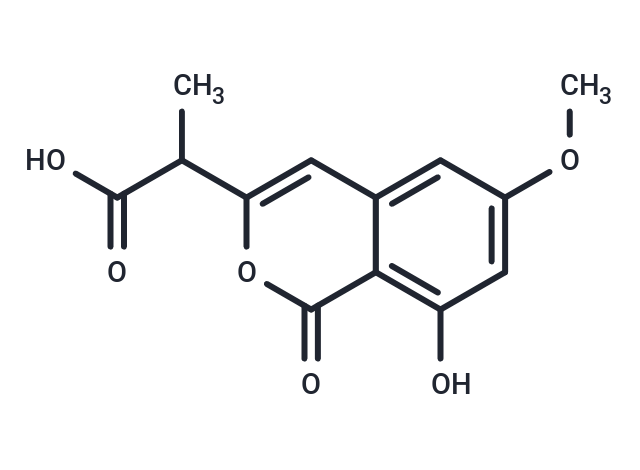Shopping Cart
- Remove All
 Your shopping cart is currently empty
Your shopping cart is currently empty

NM-3 is an orally available anti-angiogenic inhibitor with anti-tumour activity.NM-3 is used as a radiation modulator in vitro and in vivo.NM-3 inhibits vascular endothelial growth factor (VEGF), thereby inhibiting the proliferation of endothelial cells. This inhibits the proliferation of endothelial cells. NM-3 is associated with a mechanism of apoptosis induction by reactive oxygen species.

| Pack Size | Price | Availability | Quantity |
|---|---|---|---|
| 1 mg | $190 | In Stock | |
| 5 mg | $480 | In Stock | |
| 10 mg | $687 | In Stock | |
| 25 mg | $1,080 | In Stock | |
| 50 mg | $1,480 | In Stock | |
| 100 mg | $1,990 | In Stock | |
| 500 mg | $3,920 | In Stock | |
| 1 mL x 10 mM (in DMSO) | $438 | In Stock |
| Description | NM-3 is an orally available anti-angiogenic inhibitor with anti-tumour activity.NM-3 is used as a radiation modulator in vitro and in vivo.NM-3 inhibits vascular endothelial growth factor (VEGF), thereby inhibiting the proliferation of endothelial cells. This inhibits the proliferation of endothelial cells. NM-3 is associated with a mechanism of apoptosis induction by reactive oxygen species. |
| In vitro | NM-3 (100 ng/ml) is cytotoxic to human umbilical vein endothelial cells (HUVECs) but not to Lewis lung carcinoma (LLC) cells nor Seg-1, esophageal adenocarcinoma cells, in clonogenic survival assays (1,000 ng/ml ; 4h).[1] |
| In vivo | C57BL/6 female mice bearing LLC tumors were given injections for 4 consecutive days with NM-3 (25 mg/kg/day) and treated with IR (20 Gy) for 2 consecutive days. Combined treatment with NM-3 and IR significantly reduced mean tumor volume compared with either treatment alone. An increase in local tumor control was also observed in LLC tumors in mice receiving NM-3/IR therapy. When athymic nude mice bearing Seg-1 tumor xenografts were treated with NM-3 (100 mg/kg/day for 4 days) and 20 Gy (four 5 Gy fractions), significant tumor regression was observed after combined treatment (NM-3 and IR) compared with IR alone. Importantly, no increase in systemic or local tissue toxicity was observed after combined treatment (NM-3 and IR) when compared with IR alone. The bioavailability and nontoxic profile of NM-3 suggests that the efficacy of this agent should be tested in clinical radiotherapy.[1] |
| Alias | NM3, NM 3, Isocoumarin NM-3 |
| Molecular Weight | 264.23 |
| Formula | C13H12O6 |
| Cas No. | 181427-78-1 |
| Smiles | O=C1C=2C(C=C(C(C(O)=O)C)O1)=CC(OC)=CC2O |
| Relative Density. | 1.434g/cm3 |
| Storage | Powder: -20°C for 3 years | In solvent: -80°C for 1 year | Shipping with blue ice. | |||||||||||||||||||||||||||||||||||
| Solubility Information | DMSO: 27.5 mg/mL (104.08 mM), Sonication is recommended. | |||||||||||||||||||||||||||||||||||
Solution Preparation Table | ||||||||||||||||||||||||||||||||||||
DMSO
| ||||||||||||||||||||||||||||||||||||

Copyright © 2015-2025 TargetMol Chemicals Inc. All Rights Reserved.